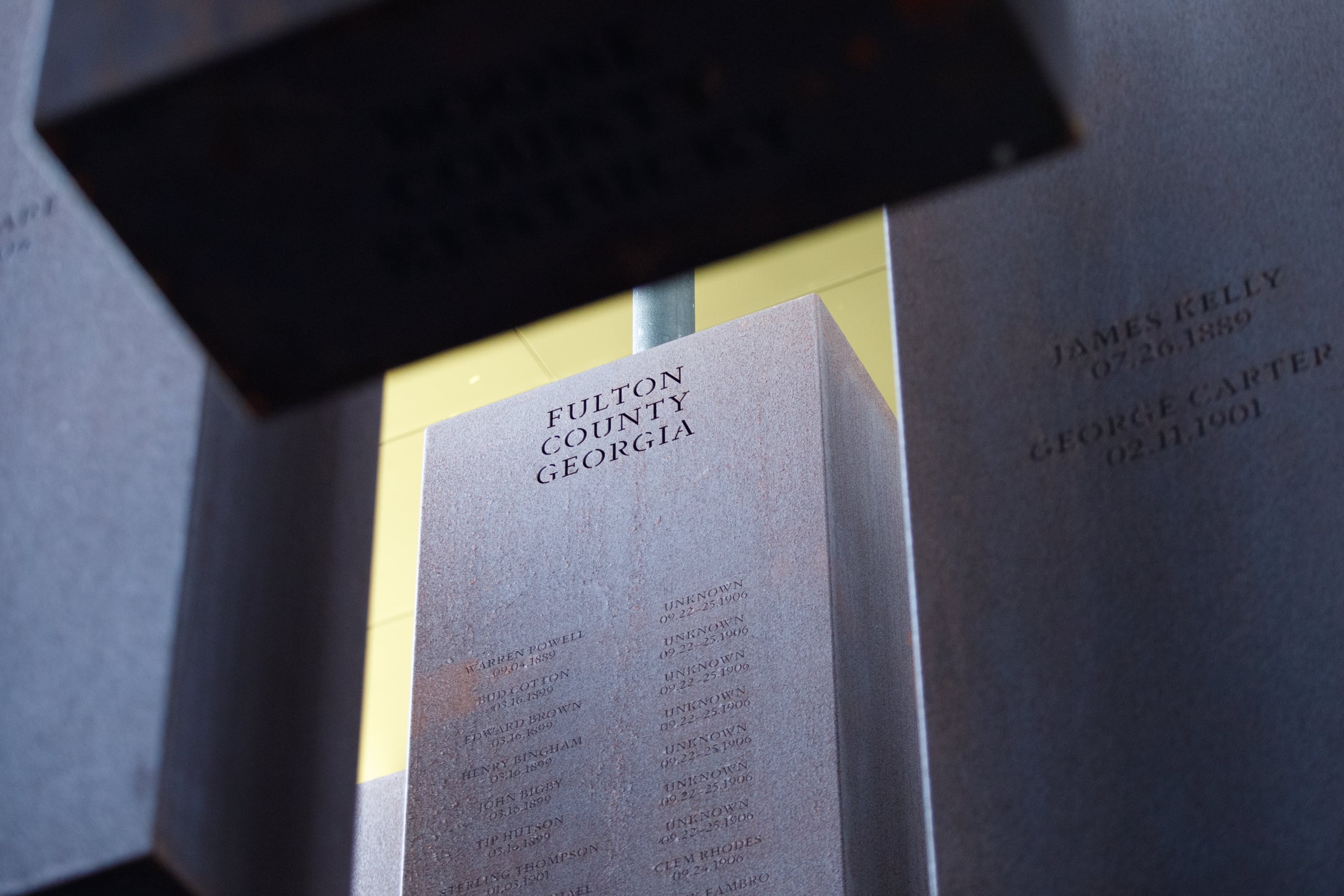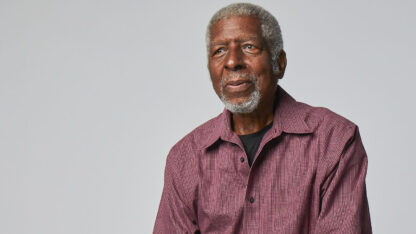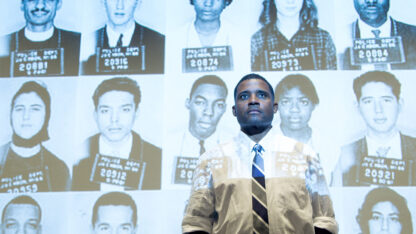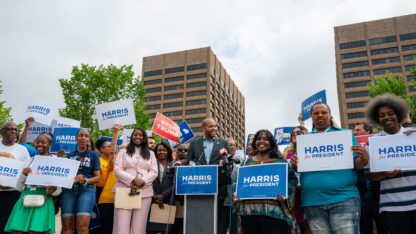This story was produced in partnership with Reveal from the Center for Investigative Reporting. Listen to its podcast about Thomas Finch here.
The first countrywide memorial to African American victims of lynching opened last year in downtown Montgomery, Alabama.
While it’s called the National Memorial for Peace and Justice, the site is not government funded. It was built by the Equal Justice Initiative, a legal nonprofit that defends against wrongful convictions and racial discrimination.
At the center of its 6 acres is an open-air pavilion with 800 hanging steel columns. Each represents a county where a lynching took place and is engraved with the names of the victims. In total, the memorial lists more than 4,000 names touching 20 states.
Looking through the names of the victims, you could get the impression that they all represent stories that have been well-documented and investigated. But that’s not exactly true.
It wasn’t in Finch’s case.
On my first visit to the memorial a year ago, I saw him listed on the column for Fulton County. It’s after the dozens of victims of the 1906 Atlanta Race Riot. That name is a misnomer for what was a massacre of black residents by a white mob.
Finch’s name is near the end. He died on Sept. 12, 1936, in the center of Atlanta. His is the last lynching listed for the city.
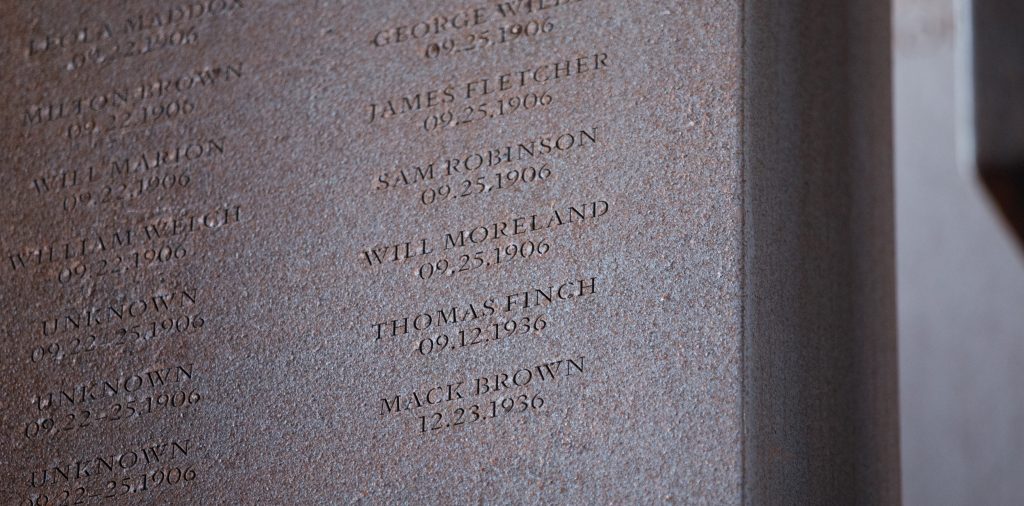
As a reporter in Atlanta, I’d never seen mention of him in city records or history books. There’s no historical marker for him around town. So I wanted to figure out who Finch was and how he died.
In the Atlanta Constitution, a newspaper that catered to white readers in the 1930s, there was only a brief story. It said a black orderly at Grady Hospital was accused of assaulting a white patient. Atlanta police arrested him, he tried to escape and reached for an officer’s gun. The officer fired three times.
But black newspapers from the time had a different perspective. The Atlanta Daily World and the Chicago Defender wrote multiple stories about Finch’s death that questioned the police account. The reporting was enough to lead to an unpublished, private investigation. It determined that Finch was lynched by Atlanta police.
With that investigation, I’d found the answer to the question of what happened to Finch. So I set out to locate the descendants of the people involved. That was when I realized that the history of this 80-year-old case wasn’t settled.

Finch’s niece was the first descendant I reached.
Joyce Finch-Morris didn’t seem surprised to hear from me. Northeastern University has a cold case project that was looking into her Uncle Thomas’s death, and the school had contacted her the year before.
We set up a time to go over the research I’d gathered at her home.
Finch-Morris lives where she grew up—in Grove Park, a neighborhood in Northwest Atlanta. Her childhood home is a 100-year-old, former schoolhouse that’s made of stone. She’s decorated the place with art she’s collected and souvenirs from her travels around the world.
As we sat down at her kitchen table, Finch-Morris was formal, a little subdued. But she didn’t hesitate to answer questions about her life or her family, although she admitted there was a lot she doesn’t know.
She said she moved back to Atlanta only a few years ago.
“I left Atlanta because I really did not like it,” Finch-Morris said. “My dad traveled a lot when I was growing up, so I saw that there were other places that offered more opportunities than Atlanta.”
She was talking partly about segregation. Finch-Morris said her parents did their best to shelter her from it. Her family was part of Atlanta’s black middle class.
But she still noticed a difference in New York, where she didn’t have to use the back door at the movies and she also thought there was more culture.
“The theater, the museums,” Finch-Morris said. “What I wanted out of New York Atlanta just didn’t have.”
As she followed a career in finance and community development, she ended up away from Atlanta for about 50 years.
During that time, she regretted that she never asked her parents for more of their history. When she was younger, she remembered, she tried to ask about her dad’s brother, Thomas. He died more than a decade before she was born.
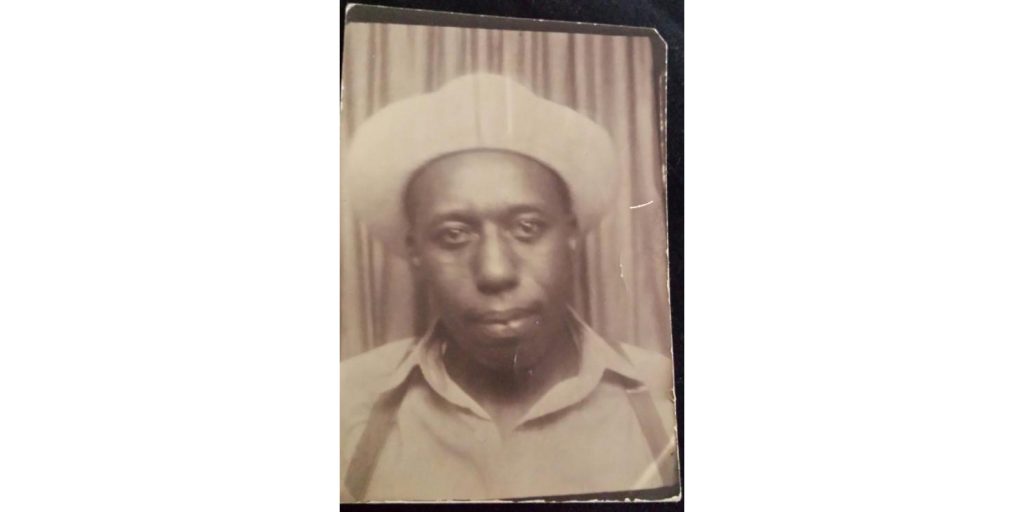
“But it was not something that was discussed,” Finch-Morris said. “And I guess I can understand—too painful perhaps? However, I wanted them to talk more freely about what happened.”
Her mom was the only one who would talk about her uncle.
“My mother said that he was lynched because he was dating someone white, and that’s all I knew,” she said. “I didn’t know any details about how and who did it.”
So, as we sat at Finch-Morris’s kitchen table, I showed her what I discovered on my laptop.
It’s the investigation into Finch’s death that I found. It was at the Atlanta University Center in the records of an early civil rights group called the Commission on Interracial Cooperation.

The commission was part of the anti-lynching movement in the 1930s. It collaborated with the NAACP, although its leaders were mainly white. They were more conservative too.
The narrative in the commission’s report began two days before Finch was shot.
That was when a white woman named Ozella Smith came into Grady Hospital. She had a broken limb. So Finch, who was an orderly, wheeled her to the white emergency room.
Smith was treated, and she left. The next day she came back for more treatment. And, once again, she left.
There wasn’t any sign of a problem until that night when police came to the hospital saying Smith had accused Finch of rape.
Grady’s white hospital staff told the commission the rape couldn’t have happened. For one, the closet where it allegedly took place was between doctors’ offices.
“It is unbelievable that the woman would have submitted silently to such an attack when the slightest outcry would have brought a dozen people to her rescue,” the commission wrote.
But the group was more worried about what happened next.
It said officers got ahold of Finch’s address at about 9 p.m. But they waited until 3 a.m. before showing up at Buttermilk Bottom, the black neighborhood near downtown that has since been demolished.
Detectives S.W. Roper and J.W. Cody got Finch out of bed. Meanwhile, a few others—it’s not clear who—were waiting in the yard and several cars had parked down on Piedmont Avenue.
The detectives never took Finch to the police station downtown. Instead, an hour later, they dropped him off at Grady Hospital, his workplace. He had been beaten and shot.
The commission didn’t need to know where exactly he had been during that hour. In a statement, the group made its position clear.
“All taken together, it seems obvious that Finch was lynched either by the police or by persons to whom the police delivered him,” the commission wrote, “and that Tom Finch was innocent of the crime which his accuser tardily reported to police.”
But I had one more thing to show Finch-Morris that wasn’t in the commission’s report. It was a news article from more than a decade later, involving S.W. Roper, the officer who said he shot Finch in self-defense.
The 1949 headline announced that Samuel Roper became the national leader of the Ku Klux Klan.
As I shared all of this with Finch-Morris, she stayed very still. At most, she scrunched her eyebrows as she tried to make sense of the new details.
By the end, her thoughts shifted to the present.
“The question is where can this all lead? Could he be exonerated after the fact?” she wondered aloud.
I asked Finch-Morris if that were something she would want.
“If he was innocent, of course, yes,” she said. “If it could be proven that he was murdered and the people responsible—are dead, I’m sure. But if the record could be cleared or clarified, I would say, yes, I’d go for it.”
The record wasn’t cleared in the 1930s after Finch died.
The commission’s file about Finch included a handful of letters to white pastors at churches that included St. Luke’s and Peachtree Road United Methodist Church. They talked about calling for a thorough investigation in Finch’s case, even a grand jury. The tone was urgent.
Then, the letters dropped off.
The commission’s report never became public. Records from the Atlanta City Council and Grady Hospital don’t show any indication that the city investigated the rape charge against Finch or the circumstances of his death.
I asked University of Georgia professor E.M. Beck if I was missing something. It seemed within the realm of possibility that a city like Atlanta could have looked into Finch’s case. A few years before, the city secured rare convictions against white men who killed a Morehouse student in a case that attracted months of media attention.
But Beck said white people ran Atlanta in the 1930s, and they would have seen the minimal coverage of Finch’s death, especially in the city’s white newspapers.
“Think about it this way: It’s an all-white power structure,” Beck said. “And so you’ve got to ask what is it in their interest to try to pursue these things, especially if it involves the police. And I would say that they have no interest in it.”
“The question is where can this all lead? Could he be exonerated after the fact?”
Joyce Finch-Morris, Thomas Finch’s niece
Beck has spent the last few decades developing a lynching database—the most accurate one that exists, he said. He was one of the only experts I reached who had any record of Finch, although he hadn’t seen the commission’s report.
He said the fact that the case began with a questionable allegation of rape, according to the commission, was not unusual. Just three decades earlier, Atlanta saw the 1906 race riot start because of allegations that black men raped white women even though there was no evidence that the assaults had occurred.
But the role of police does put Finch’s death in murky historical territory. It even made civil rights groups uneasy at the time. In letters, the NAACP initially wouldn’t call his case a lynching because of the claim he was resisting arrest.
Among the thousands of cases Beck has confirmed, he said he could think of maybe 30 that he would call police lynchings. He said it’s hard to know if there were more because the only written records are often reports from the officers themselves.
The one thing historians are certain about, Beck said, is that the Ku Klux Klan specifically tried to recruit police officers in the 1920s and 30s when the hate group had surged in popularity.
In Atlanta, the Klan’s influence in the all-white police force went well beyond Roper, the officer who shot Finch. A former Atlanta police chief, Herbert Jenkins, said as much in a 1970s oral history recording with the late historian Cliff Kuhn.

“At one time most of the members of the police department were members of the Ku Klux Klan,” Jenkins said. “And there were some officers in the Klan that were also officers in the Atlanta police department.”
Knowing about the Klan’s influence in the department, it’s hard not to wonder about other police shootings from the time. J.W. Cody, the officer who joined Roper the night of Finch’s arrest, was involved in at least five other fatal shootings of black men during his career, according to newspaper reports in the Atlanta Daily World. In one case, he killed a suspect with a machine gun.
But so many years later, there’s no proof that these were anything other than officer-involved shootings.
That’s what makes Finch’s case stand out. Someone did investigate his police shooting in the 1930s. After Beck, the professor, read the commission on Interracial Cooperation’s report, he said it was the best evidence available today that Finch’s death was a lynching.
But the documents weren’t all that I was interested in. There were other people connected to Finch’s case: Ozella Smith, the woman who accused him of rape, and the two detectives, especially the one who shot him, Samuel Roper. I still needed to talk to their families.
It wasn’t hard to trace Roper’s life. He had another public role before leading the Klan. He led the Georgia Bureau of Investigation under Georgia Gov. Eugene Talmadge.
I looked up his obituary, and, from there, I was able to find his grandson, Kent Giles.
He’d never heard of Finch. At first, he was hesitant to do an interview, but after we talked a few times and went over my research, he agreed. So I drove out to his new house in Marble Hill, a rural area an hour north of Atlanta.
Giles already had a place prepared at his table. There were the documents I’d given him and a notebook where he’d written down names and facts. He was friendly, but once the recorder was on, the room felt tense.
Giles explained what made him nervous to talk about his grandfather.
“I just think that there’s always a risk by association,” Giles said. “I think most people understand that none of us are our ancestors. If we go far enough back, we all have ancestors that you know did things good and bad.”
Growing up, Giles said he knew his grandfather. Roper lived until he was 90. Giles would see him on visits to Florida, where his grandfather had retired.
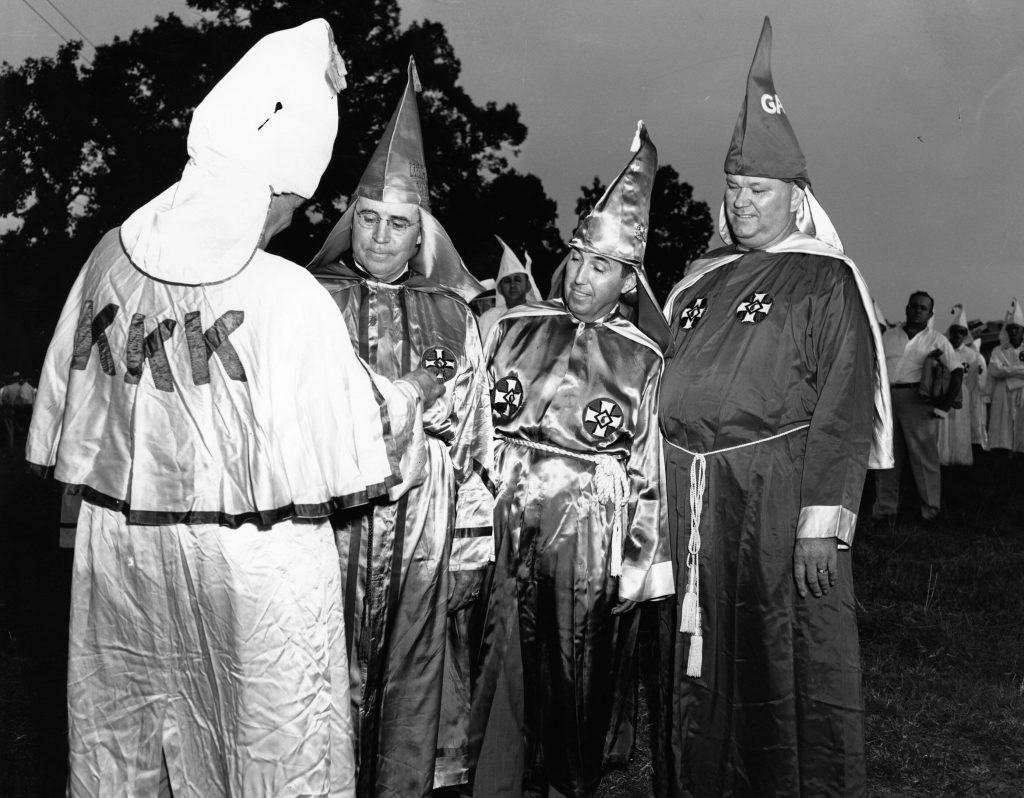
They would talk about Roper’s service in the First World War, in law enforcement, and eventually the Klan. Giles said the way he understands it now his grandfather only joined to get ahead in politics. He asked about the violence for which the hate group is known.
“I said you know when you were head of the KKK—which actually I think he was a grand imperial wizard maybe a total of a year to 18 months, so it wasn’t very long. He said that he never condoned lynching,” Giles said. “And newspapers report him as saying that you know we will consider our political activism for white supremacy, but we will not condone violence.”
There was a newspaper article where he said that. But there was also another article where the Klan was accused of bombing the homes of black families in Atlanta. That was under Roper’s watch.
Giles explained that his grandfather blamed violence that did happen on fringe members. He said Roper was more like the governor he served under, Eugene Talmadge, a Klan sympathizer who fought to keep black people from voting.
“Now there’s no question, their politics was segregationist. It was white supremacist. So most of the things that I understood about them were political things.” Giles said. “These were men who were enforcing the law and getting elected in high office. They weren’t men who really wanted to act like criminals.”
When I asked Giles what he made of the commission’s findings, he went through the documents point-by-point.
He agreed there were aspects of Finch’s arrest that seemed off. There was the fact that officers never took him to the police station, which would have been a short trip downtown. Instead, the officers said they brought him to his accuser’s house in Grant Park to be identified.
“Think about it this way: It’s an all-white power structure. And so you’ve got to ask what is it in their interest to try to pursue these things, especially if it involves the police.”
University of Georgia professor E.M. Beck, on Atlanta in the 1930s
But where the commission saw a police-sponsored lynching, Giles said he saw something else.
“What I read into this event is that the police were concerned that there was going to be a lynching or some kind of activity either by the accuser’s family or some racist group in town,” Giles said.
In other words, he believed his grandfather was trying to protect Finch from a mob, not that he was conspiring with one.
Then, he said Finch tried to escape and reached for his grandfather’s gun. Giles said, according to law enforcement officials he’s talked to, Finch’s gunshot wounds in his neck, chest and abdomen matched how officers were trained to shoot, although I could never find that in any police manual.
Ultimately, Giles took the same position as his grandfather: The shooting of Finch was self-defense, a justifiable homicide.
He said he understood how others might find the commission’s account of what happened more convincing. I asked what he would say to those people who hear about a case that a civil rights group called a lynching, learn that the shooter involved became leader of the Ku Klux Klan and then choose the simplest explanation.
“I would say to them you know I’m viewing this through as much truth as I can find—which there’s a lot of missing pieces—and through the filters of a man I knew,” Giles said. “The only thing I can say truthfully is I don’t know what really happened, and I don’t think we’re ever going to really know what happened.”
After speaking with Roper’s family, I also located descendants of his partner the night Finch died, Officer J.W. Cody, and left them voicemails. But they didn’t return my calls.
So I turned my attention to the one person remaining in this case: Ozella Smith, the white woman whose complaint of rape led police to arrest Finch.
She was more difficult to track after the case. It wasn’t until I figured out that she died in the 1980s with a different first name that I was able to locate her niece, Dolores Sharp.
She agreed to meet me in a library study room near where she lived in Peachtree City, an hour south of Atlanta.
Like Giles, Sharp was cautious. We spent a couple of hours going over documents before she was OK to talk on the record.
She also knew and grew up around her aunt. She saw her whenever she went to her grandma’s house because that’s where Smith lived. She never married.
And Sharp had heard of the case, at least part of it.
“I was a young girl when I was told that my aunt was raped by a black person at the hospital,” she said. “I never really knew a lot of details, and, because it was taboo to talk about, you didn’t bring it up. And I don’t know why I was mature in the sense that I felt like maybe it was something that I didn’t need to plunder into.”
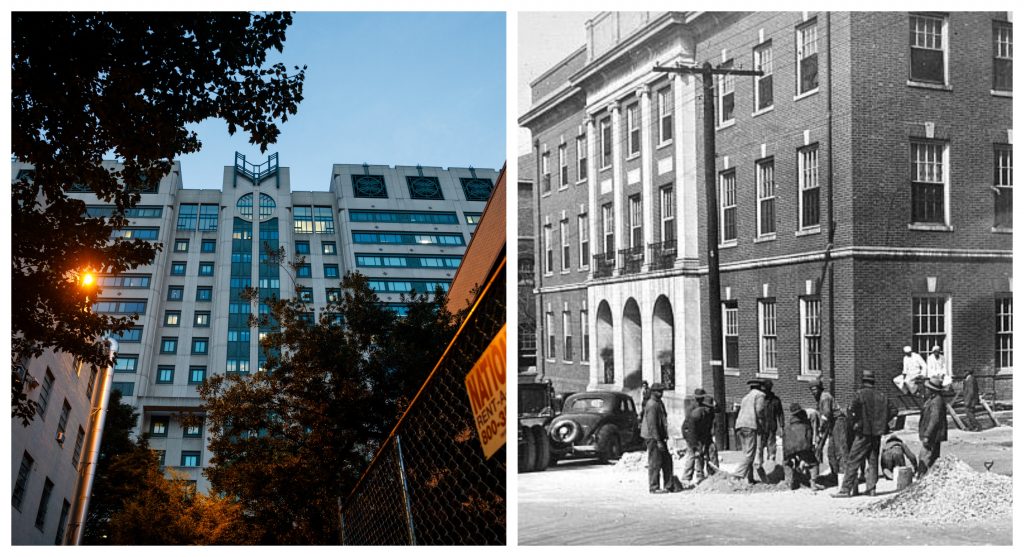
Whatever took place with her at Grady Hospital in 1936, Sharp said she believed her whole family still hurt.
“I think it was maybe a major event that permanently scarred the heart and the mind of the members that were closest to my aunt,” she said. “It’s like seeing a child, something like that happened to a child because she was very childlike and untouched.”
The conviction in Sharp’s voice was audible.
Smith was 22 at the time of the event. Sharp described her as sweet and quiet. The commission, quoting a psychiatrist, wrote that she was “mentally subnormal.”
As we shifted to the subject of the commission’s report, Sharp called the documents disturbing. The group concluded that Finch was wrongfully accused. The implication was that her aunt lied about the assault.
“When you hear something contrary to what you grew up believing you might even go on a defense of that,” Sharp said. “Or you might take the attitude that she was just completely discarded. Or that what happened to her was completely irrelevant.”
At this moment, though, Sharp’s thought was interrupted. A Peachtree City librarian motioned through the glass of the study room to let us know our time was up.
Before we left, she told me one more thing. It was her theory about the case: When the Grady Hospital staff said her aunt couldn’t have been raped, she said she thinks they were trying to cover up what may have really happened.
“What I feel about it is that the hospital totally went for protecting the integrity and the reputation of the hospital,” Sharp said.
She too sided with her family’s account.
Sharp then asked if we could reschedule. But weeks went by, and she never agreed to another time.
This is where all of my reporting led: three different family views on one 80-year-old case.
As I stayed in touch with Joyce Finch-Morris, it became clear that her family also believed one key detail that wasn’t in the commission’s report—that Finch was killed for being in a consensual relationship with a white woman, not just that he was wrongfully accused of rape. Finch-Morris connected me with cousins who confirmed this belief.
This wasn’t the result I expected—disagreement about something that happened so long ago—but I was naive. Catherine Meeks affirmed that. She’s a former African American studies professor who now directs the Absalom Jones Center for Racial Healing. It’s a project of the Episcopal Church.
“We don’t agree about the history. We don’t agree about the written history of the United States,” Meeks said.
She said people see history the way they want to see it. And lynching, in particular, is a point of shame.
“That’s one piece of the history that we’ve tried to the hardest to ignore,” she said. “We will talk about slavery. We’ll talk about Jim Crow. We’ll talk about reconstruction, but we don’t really want to talk about lynching.”
Many places in Georgia still don’t want to talk about lynching even though more were perpetrated here than in any other state except Mississippi.
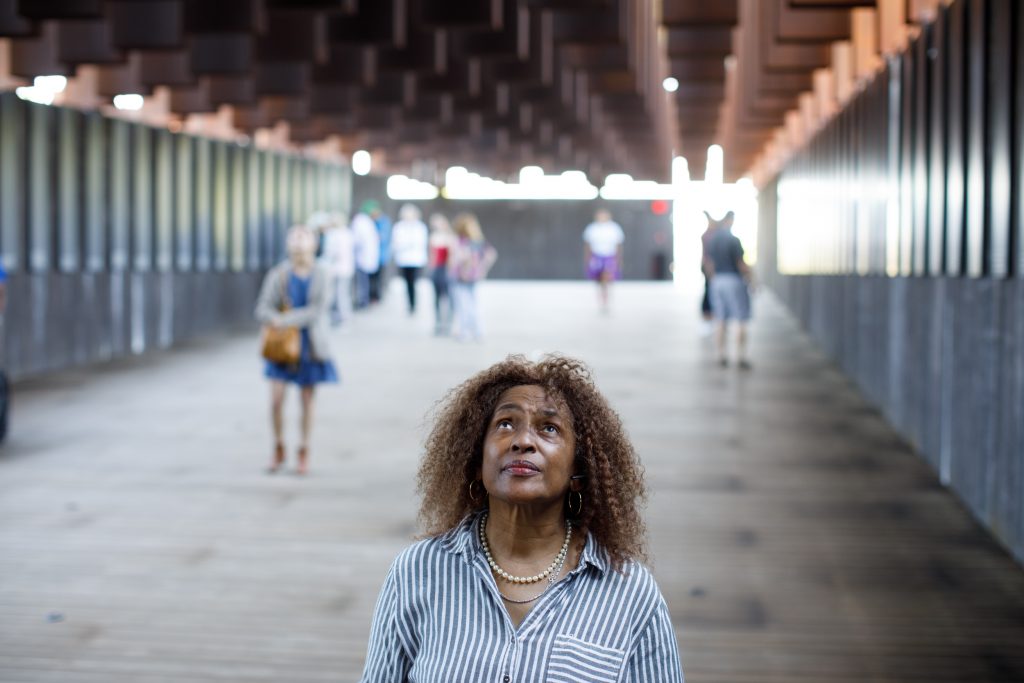
A couple of years ago, a police chief in LaGrange made a rare apology for a lynching. I was there covering the event. Two-hundred people crowded into the Methodist church as Chief Lou Dekmar talked about Austin Callaway, who was killed in 1940 after a mob stormed the city jail.
“I sincerely regret and denounce the role our police department played in Austin’s lynching,” Dekmar told the audience. “Both through our action and our inaction. And, for that, I’m profoundly sorry. It should never have happened.”
His comments that night received a standing ovation and drew national attention.
But in Finch’s case, it doesn’t seem like authorities have any plans to apologize.
I let the city of Atlanta and the police department know about what I found. I sent emails, even registered letters. Would they acknowledge his case as a lynching?
Atlanta’s police chief Erika Shields declined to talk to me. The office of Mayor Kiesha Lance Bottoms only gave a short statement. It said the city has no official record of Finch’s case, but there was no denying that Atlanta “still wears scars from the deep wounds inflicted during that dark chapter of history.”
And this surprised me, too.
Atlanta’s very different now. The all-white power structure is gone. It’s had black mayors for decades. And the police force is majority black. But when it came to Finch’s case, they still had little to say.
“Well, I just think it’s a denial of the history. I think they don’t want to take responsibility,” Meeks said. “They may even be worried that if they say something they will be admitting to some culpability that might lead them in[to] legal trouble. You know there are just all kinds of fear-based reasons for not stepping up to the plate of truth.”
“He’s memorialized. He’s not forgotten. I didn’t even know him. But it’s important.”
Joyce Finch-Morris, Thomas Finch’s niece
Meeks said it doesn’t matter if the people in power have changed; the institutions still need to recognize what happened.
“It’s not as important for me for somebody to go stand up in front of a microphone and say, ‘I’m sorry,’ as it is for them to really be awake to really understand and to really do something,” Meeks said. “But if you’re doing all of that you probably don’t mind saying you’re sorry.”
For now, the most public acknowledgment of Finch is still in another state, the place where I first came across his name and where there are no questions about his death: the memorial for lynching victims in Montgomery, Alabama.
Several months after we met, I joined Finch-Morris at the memorial.
We walked down into the lower level of the main pavilion, past a wall with streaming water. Hundreds of steel columns shaped like coffins were hanging above us, organized by the counties where the lynchings happened.
Finch-Morris moved through the columns quickly, looking for her uncle’s name. She seemed anxious, almost excited.
When we found the column for Fulton County, it was so high above us that Finch-Morris strained to make out the names of the victims etched on the column.
WABE’s photographer had to take a picture of the column and enlarge it on the screen of his camera. Then, Finch-Morris saw her uncle’s name for herself.
She stayed in the area a moment, taking it all in—his name among 4,000 victims of lynching in the U.S.
Then, she approached me.
“I’m really reserved most of the time, and I hold my feelings in. I never knew my uncle. But I can pass this along to my family members and to my grandkids,” Finch-Morris said.
She paused. Her voice started to break.
“I mean, this is history,” she said. “He’s memorialized. He’s not forgotten. I didn’t even know him. But it’s important.”
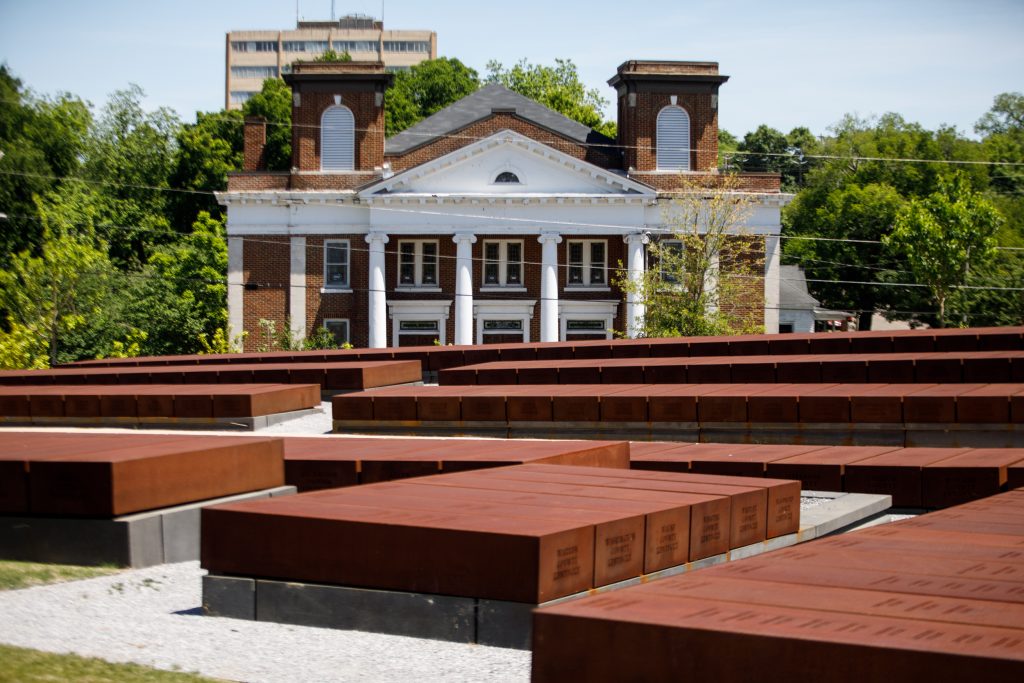
We left the pavilion and came to a courtyard just outside. Here there was another set of columns lined up on the ground.
These were duplicates. The group behind the memorial intends to send them to the counties where the lynchings happened, so the columns can be like historical markers.
In Atlanta, there’s a group of private individuals called the Fulton County Remembrance Coalition, already working to bring Fulton County’s column back. It would finally bring Finch public recognition in the city where he was killed more than 80 years ago.
After spending all this time on his case, I can’t say how that effort will be received.
This story is part of an investigative journalism collaboration among WABE, KPCC in Los Angeles, WNYC in New York, KCUR in Kansas City and APM Reports. It is supported by the Corporation for Public Broadcasting.
